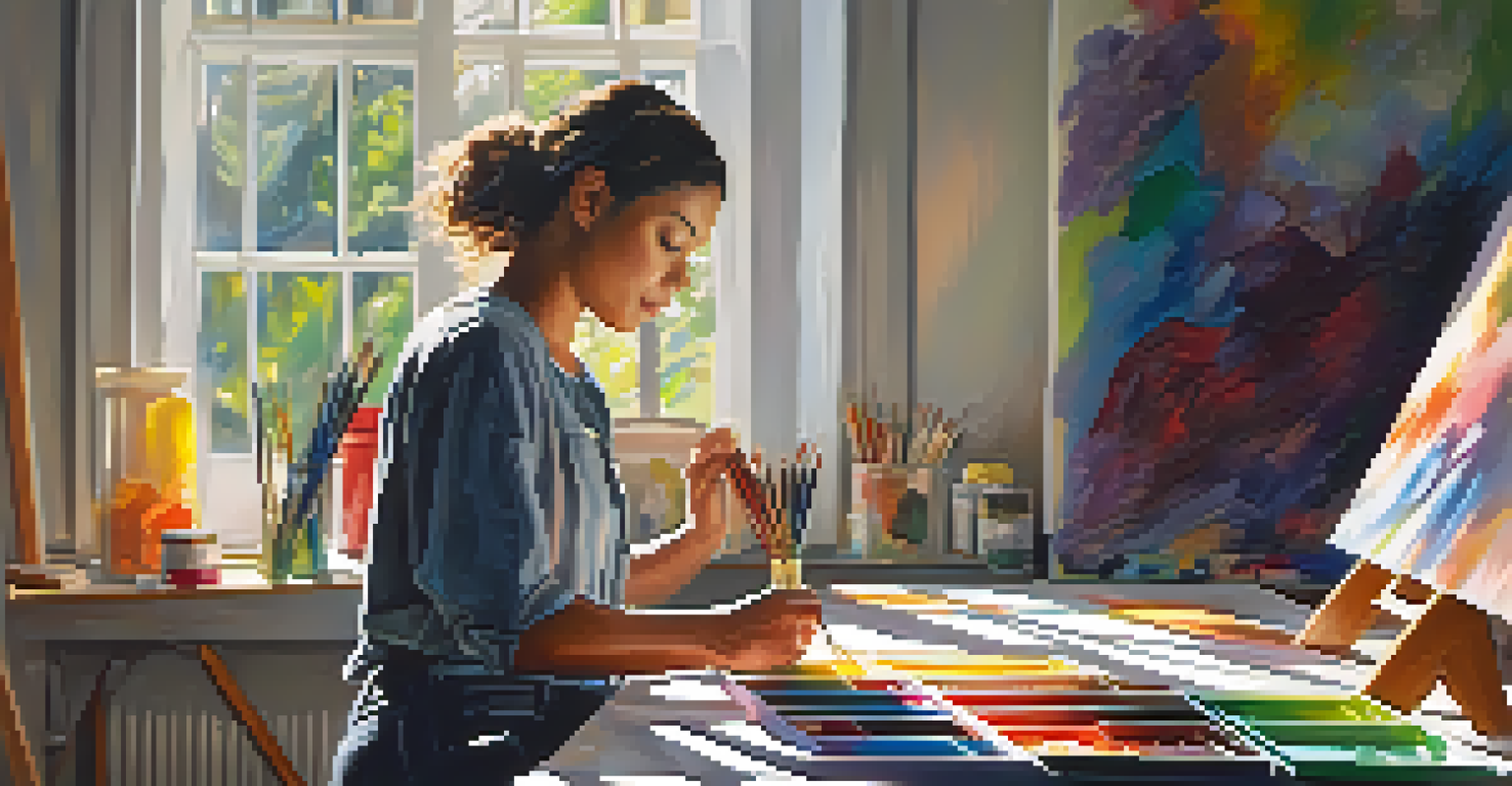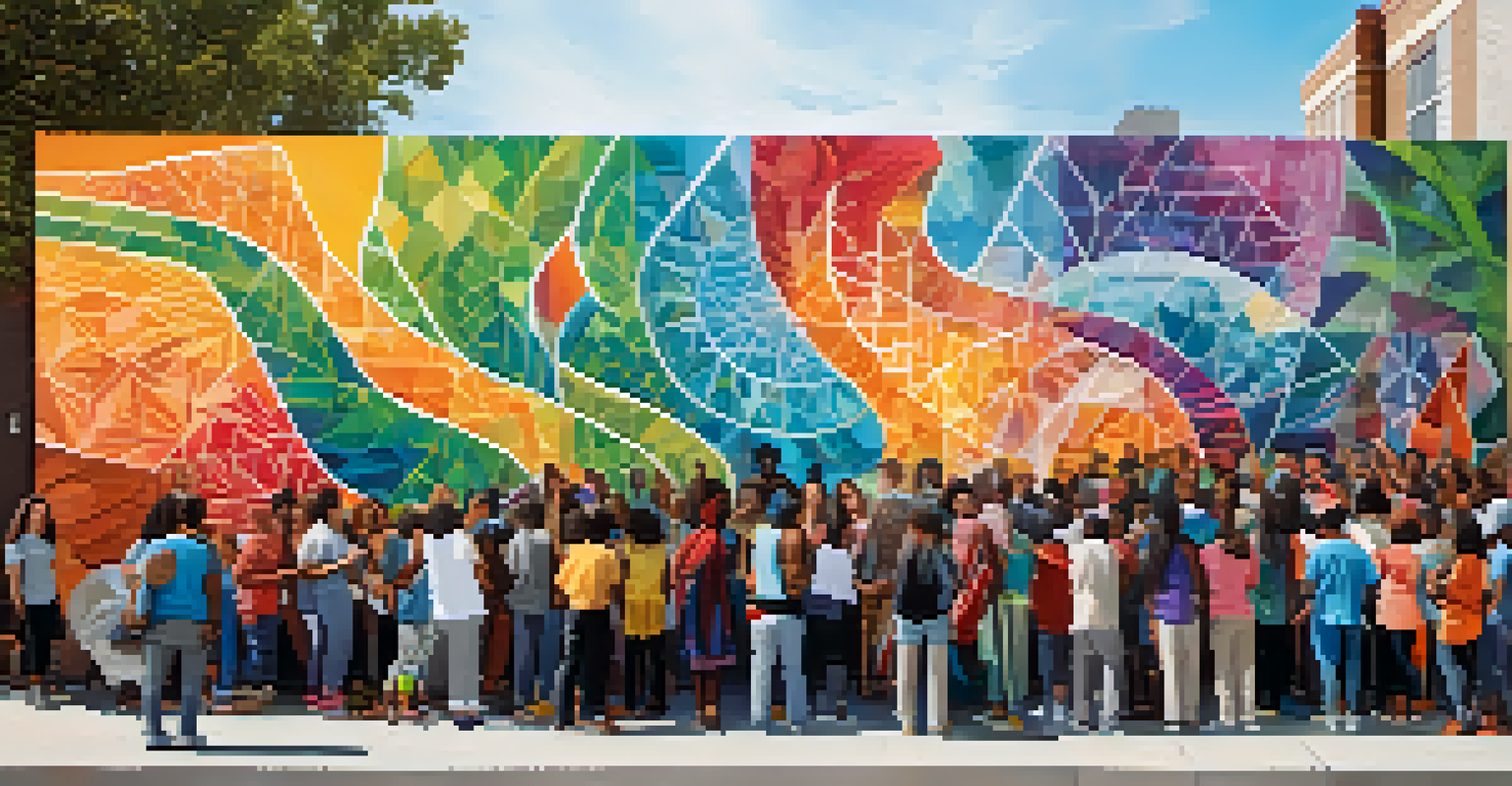The Connection Between Art and Spirituality: Emotional Insights

Understanding the Link Between Art and Spirituality
Art and spirituality have shared a deep bond throughout human history. Both express the profound aspects of our existence and explore themes like love, loss, and transcendence. Artists often channel their spiritual experiences into their work, creating pieces that resonate with the soul. This connection invites viewers to reflect on their own spiritual journeys and emotional states.
Art is the most beautiful of all lies; it is the greatest truth we have.
When we engage with art, we often find ourselves confronted with feelings and ideas that can be difficult to articulate. A stunning painting or a moving piece of music can evoke emotions that resonate within us, prompting introspection. Just as spirituality encourages personal exploration, art serves as a medium through which we can examine our inner worlds. This dual exploration can lead to significant emotional insights.
For many, the experience of creating or observing art becomes a spiritual practice in itself. It allows individuals to connect with something greater, whether that’s their inner self or a sense of universal energy. This interplay between art and spirituality acts as a bridge, inviting us to explore the emotional landscapes that define our human experience.
Art as a Form of Spiritual Expression
Artists often use their mediums to express complex spiritual experiences. Whether through painting, music, or dance, these expressions can convey feelings that words sometimes fail to capture. For example, a serene landscape painting might evoke a sense of peace, reflecting the artist's inner tranquility and inviting viewers to experience that same calmness.

Spirituality can manifest in art in various ways, from depicting religious themes to exploring the concept of nature as a divine entity. Consider how the intricate designs in mandalas invite contemplation and meditation; these works not only beautify spaces but also serve as tools for spiritual connection. Each brushstroke or note played can transport both the creator and the audience into a contemplative state.
Art as a Spiritual Medium
Art serves as a powerful tool for personal and collective spiritual expression, facilitating emotional reflection and connection.
This form of expression not only reflects the artist's beliefs but also resonates with the audience's personal experiences. Each observer brings their unique interpretation, creating a shared space for emotional and spiritual reflection. This interaction enhances the understanding of spirituality, making art a powerful vehicle for exploring deeper emotional truths.
The Emotional Impact of Artistic Experiences
Engaging with art can lead to profound emotional experiences. A poignant song might bring tears of joy or sorrow, while a captivating sculpture can inspire awe. These reactions often stem from a deep connection to the themes presented, reflecting our own life experiences and spiritual questions. Art has a unique ability to tap into our emotions, often making us feel seen and understood.
The purpose of art is not a rarified, intellectual distillate; it is life, intensified, brilliant life.
Moreover, the emotional impact of art can foster healing and personal growth. Many people turn to creative outlets during challenging times, using art as a means to process their feelings. This therapeutic aspect emphasizes the importance of art in spiritual practice, providing a safe space to explore emotions and find solace.
As we navigate our emotional landscapes through art, we can uncover insights about ourselves that may have remained hidden. This journey of self-discovery allows us to connect not only with the artwork but also with our own spiritual paths. Ultimately, the emotional impact of artistic experiences serves to enrich our understanding of both art and spirituality.
Art as a Tool for Spiritual Connection
Art can serve as a powerful tool for fostering spiritual connection. Whether through creating or experiencing art, individuals often find themselves in a meditative state that enhances their awareness of the present moment. This mindfulness can lead to deeper insights about oneself and the universe, revealing the interconnectedness of all things.
Many spiritual practices incorporate art as a means of connecting with the divine. For instance, religious rituals often involve music, dance, or visual art that enhance the spiritual atmosphere. These artistic expressions help participants feel a sense of unity with something greater than themselves, reinforcing the idea that art can be a pathway to spiritual enlightenment.
Emotional Healing Through Art
Engaging with art can lead to profound emotional insights and healing, allowing individuals to process their feelings and experiences.
In this way, art transcends cultural and religious boundaries, creating spaces where individuals can explore their spirituality. Whether it’s through attending a gallery opening or participating in a community art project, these experiences can deepen one’s sense of belonging and connection to the world around them. Art becomes not only a personal journey but a collective spiritual experience.
The Role of Art in Spiritual Communities
Art plays a significant role in spiritual communities, serving as a medium for shared beliefs and values. From murals in places of worship to group art projects, these creations often reflect the collective spirit of the community. This shared experience fosters a sense of belonging and unity, reinforcing the bonds among members.
In many spiritual traditions, art is used to tell stories, convey teachings, and celebrate rituals. For example, traditional dances often express cultural narratives and spiritual teachings that have been passed down through generations. These artistic expressions not only keep traditions alive but also create a sense of continuity and connection to the divine.
Moreover, engaging in artistic practices within spiritual communities can enhance personal growth and emotional healing. When individuals collaborate on art projects, they often share their experiences and perspectives, leading to deeper understanding and empathy. This communal aspect of art strengthens the spiritual fabric of the community, reminding us of our shared humanity.
Personal Stories of Art and Spiritual Transformation
Personal narratives about the transformative power of art abound. Many individuals recount how creating or experiencing art brought them closer to their spiritual selves during times of struggle. For example, someone may find solace in painting after losing a loved one, using the canvas to express grief and ultimately find healing and hope.
These stories highlight the unique capacity of art to facilitate personal transformation. Artists often share how their creative journeys led to spiritual awakenings, revealing insights that changed their perspectives on life. An artist’s struggle with their craft can mirror the spiritual journey of overcoming obstacles and finding inner peace.
Community and Shared Experiences
Art fosters unity within spiritual communities, reinforcing shared beliefs and values while promoting personal growth and empathy.
Such personal accounts emphasize the profound emotional insights gained through the intersection of art and spirituality. They remind us that everyone’s journey is different, yet we can find common threads of healing, growth, and connection through our artistic expressions. This shared experience reinforces the idea that art is a universal language of the spirit.
Conclusion: Embracing the Art-Spiritual Connection
The connection between art and spirituality is rich and multifaceted, offering countless opportunities for emotional insights. By exploring this relationship, we can deepen our understanding of ourselves and the world around us. Whether through creating, experiencing, or reflecting on art, we find pathways to explore our spiritual journeys.
As we embrace the art-spiritual connection, we open ourselves to a world of possibilities. Art invites us to engage with our emotions, providing a space for healing and reflection. In turn, spirituality encourages us to explore our creativity, helping us to express our innermost thoughts and feelings.

Ultimately, the interplay between art and spirituality enriches our lives in profound ways. By appreciating this connection, we can cultivate a deeper understanding of our emotional landscapes and spiritual paths, creating a more vibrant and fulfilling existence.